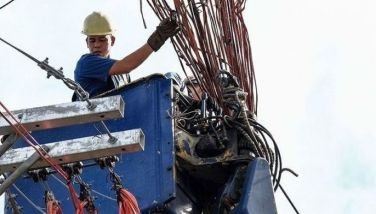Native trees and national development

This is the time of year when many of our countrymen troop to the churches and through national highways for a vacation to cooler places. The summer heat brings to mind the shade and comfort that trees provide.
Native trees and their varieties. As I write, I have with me three weighty materials on the subject of native trees.
The first is a hand-copied sketch of the map of the Washington SyCip Garden of Philippine Native Trees which is found on the backside of the big white sign standing in the garden. Located on a piece of land just across the street from the UP Alumni Building, the garden of trees is beside the UP Carillon and the UP Film Center building. Hundreds of young trees are now nearing four years in transplantation.
The second is a book by botanist Emiliano D. Sotalbo, Trees, Palms and Bamboos of the University of the Philippines Diliman (UP Press, 2001). This is an illustrated book of flora that are planted in the UP Diliman campus, a botanically diverse urban community. It is made more diverse with the arboretum that UP has been maintaining for decades, aside from its widely planted campus community.
And the third is a book entitled Philippine Native Trees 101: Up Close and Personal (published by Green Convergence for Safe Food Healthy Environment and Sustainable Economy and by Hortica Filipina Foundation Inc., 2012).
All these materials have made me acutely aware of the subject of trees.
Defining native trees. Three commonly used terms in the two books are ‘native’, ‘indigenous’, and ‘endemic’. My Webster dictionary defines them as synonyms. As applied to plants, ‘native’ denotes plants born or originating in the country; ‘indigenous’ is in reference to the natural origin of the plant; and ‘endemic’ suggests prevalence in or restriction to a particular region – in this sense – the country.
If this distinction still confuses, we have to get to actual examples. The mango tree (Mangifera indica) is indigenous to Asia and is cultivated throughout our country. Our books classify it as an indigenous plant. Yet we know that it is also native or indigenous to other countries.
As another example, take the case of narra (Pterocarpus indicus). It is indigenous to Southeast Asia, including Burma, Thailand, Cambodia, Indonesia, and other Pacific islands. Like the mango, it is native to other countries too.
The case of guayabano, atis and anonas – all members of the same family of trees – is different. These plants were introduced from tropical America to the country for their edible fruits. They are not native. But do we love these fruits?
This brings me to another well-known example in the case of large trees. The acacia (Samanea saman) is a well-known tree in the country. It was brought into the Philippines during the American colonial period and has thrived very well in our setting, adding grace and comfort to our living.
Known as ‘raintree’ in the United States, its most famous display in the country could be the acacias on the academic oval of the UP that provide majestic shade to the campus scenery and almost define the UP arboreally.
It is said that the acacias were planted by President Bienvenido Gonzalez around 1949, but I do not believe this to be so. When I first entered the UP in 1953, this academic oval of acacia trees had already existed and the trees – at least the tree trunks – of most of them were already large, though not as massive as today. The trees could have been planted much earlier, perhaps during the early years when the US Signal Corps was still stationed in what is now the UP campus.
There are other examples of such groupings of acacia groves: those lining McKinley Road as one goes to and from Ayala Boulevard and Fort Bonifacio in Makati in the Forbes Park area, and some parts of Pampanga where the Clark Airbase is located.
Narrowing base of native trees. The main theme of Philippine Native Trees 101 is to raise national awareness about the state of native trees and to reverse the trend of declining presence in the face of growing competition from foreign varieties.
The book decries the loss of dominance of native varieties as a result of deforestation and other developments. For instance, Ronald Achacoso (of the Philippine Native Plants Conservation Society) laments the lost or diminution of the country’s dipterocarp varieties of trees known collectively in the world of lumber trade as Philippine Mahogany.
These trees had such indigenous names as apitong, bagtikan, yakal, lauan pula or puti, among others, part of about 40 species of such magnificent trees that formed the backbone of the country’s lowland rain forest and which dominated the archipelago.
The book presents a good collection of the country’s natural riches in trees. There is still something to celebrate and to be proud of. One hundred four individuals of note (botanists, urban planners, gardeners, plant lovers, professionals, politicians, well-known individuals) express in life their own connections with native trees).
Beautiful color photography of Philippine trees is in this book, thanks to Araceli Tungol, chief photographer, together with prized photos of other tree naturalists. In addition, there are outstanding photos made by the late, celebrated botanist Leonard Co (who was unfortunately killed while on some field trip in the mountains collecting specimens and photos of Philippine botanical treasures).
As Dr. Angelina P. Galang (the president of the Green Convergence for Safe Food Healthy Environment and Sustainable Economy) states in the preface,” ... many of our native trees are disappearing... due to deforestation, replacement by alien species and monocrop plantations that propagate only commercially popular varieties. Sadly, another major reason is preference for exotic and alien flora....”
With optimism, she adds: “Our native trees are of all sizes, shapes of green in combination with various hues of other colors. Leaves may range from large to tiny, round to elongated, thick to paper-thin, waxy to rough. Trunks may be ramrod straight or twisted to gnarled, singular or branched, smooth or covered with rough bark, black to pale molave. Crowns may be luxurious in spread, spare or short in branches. Roots may grow vertically down and deep, or buttressed and shallow. The combinations are endless! Thus, there are trees for any type of urban landscaping need.”
My email is: [email protected]. Visit this site for more information, feedback and commentary: http://econ.upd.edu.ph/gpsicat/
- Latest
- Trending























